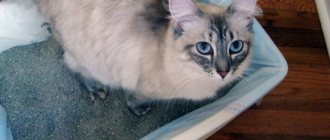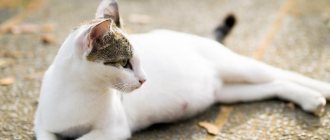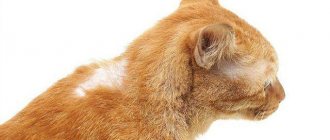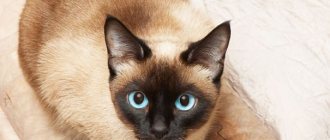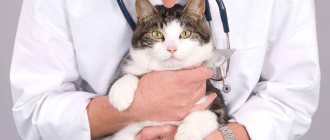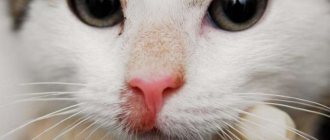Physiological reasons
Physiological factors include natural factors that do not threaten the development of pathologies, for example, pregnancy of an animal. Some of them require the intervention of their owners. The following physiological causes of a large belly in a cat are distinguished:
- pregnancy;
- nervous tension;
- flatulence;
- food poisoning.
Physiological causes of a large belly include pregnancy.
A pet's belly can increase due to muscle tension resulting from pain of any nature, or if the cat itself tenses its muscles, experiencing stress, fearing an attack.
Why does deviation occur?
The development of the deviation is influenced by pathological and physiological factors. The first are dangerous to health and require the intervention of a veterinarian. The latter are natural, so they are easy to figure out on your own.
Hazardous factors
The presence of pathology is indicated when the abdominal muscles do not relax for more than a day, and the pet’s condition gradually worsens. This is due to the following reasons:
Constipation
. It occurs due to intestinal spasms, improper feeding, ingestion of a foreign object, helminthiasis and the accumulation of hair in the intestines during heavy shedding. Without prompt treatment, constipation can lead to intestinal obstruction and death.
Pathological factors
An enlarged, hard tummy in a cat is observed with the development of a number of serious pathologies. If any abnormalities are detected, you must take your pet to a veterinary clinic. If your pet is thin and has a large belly, you need to monitor him in case he develops symptoms of disease.
We recommend this article:
How to recognize and treat intestinal obstruction in cats
Ascites
This disease is also called abdominal dropsy. Characterized by the accumulation of fluid in the peritoneum. There may be several provoking factors, including disruption of the heart or kidneys. Pathology requires careful diagnosis. Externally, the shape of the abdomen changes when the body position of the four-legged patient changes from saggy to pear-shaped.
Ascites is called abdominal hydrops
Infectious peritonitis
A serious incurable disease caused by coronavirus. Often young individuals are affected. The four-legged patient becomes emaciated, and the abdomen enlarges as fluid accumulates in the peritoneum. The pain syndrome can last for weeks. The disease continues for a month or a year until the animal dies. The main symptom of the disease is bloating.
Pyometra
The pathology affects only cats. The peculiarity of the disease is inflammation and filling of the uterus with pus. If the disease is not diagnosed in time, it continues to progress, and the cat’s abdomen as a whole increases along with the reproductive organ. Treatment involves surgery and complete removal of the uterus. The earlier the disease was identified and eliminated, the greater the chance that the pet will fully recover.
Malignant tumors
If one of the organs of the peritoneum is affected by cancer, then the cat’s abdomen increases along with the growth of the tumor. When palpated, a dense lump is revealed - the tumor itself. In addition to the large tummy, there is asymmetry - one side becomes larger than the other. More often, pathology is detected in older individuals. The lifespan of a pet is difficult to predict.
Obesity
The pathology affects those pets who live in city apartments, lead a sedentary lifestyle and receive poor nutrition, as well as spayed and neutered pets. At the initial stage of development of the disorder, fat is deposited in the groin area and the abdomen sag. If you don't change your cat's lifestyle and diet, obesity will develop. This threatens the pet's death from cardiac obesity.
Table: Determination of the physiological state of the cat
Helminthiasis
All cats are susceptible to infection with worms, even if they do not have access to the street. Helminth infestation is provoked by:
- contaminated food;
- contact with other animals and even insects;
- access to the owner's outdoor shoes.
Even if your pet has regular bowel movements, the peritoneum may be swollen due to the accumulation of parasites inside.
Coprostasis
The pathology is characterized by blockage of the large intestine, due to which there is no bowel movement for several days. Along with the accumulation of feces, the cat's belly grows. Causes of the disease:
- sudden change in food type;
- lack of protein in the diet;
- dehydration;
- binge eating;
- blockage of the intestines with lumps of licked hair;
- defeat by helminths, which accumulate and block the intestinal lumen.
Viral infection
Panleukopenia, or feline distemper, is a dangerous disease that often leads to the death of a pet. Rare pathology. The virus is carried by blood-sucking insects, so even pets that do not have access to the street are not protected from infection.
All news
In Rostov, due to football, traffic will be limited on March 15
A truck engulfed in fire on the Rostov-Taganrog highway was caught on video
Rostov authorities have chosen an area for renovation
The day of voting on amendments to the Constitution was declared a holiday
The prosecutor's office will check the bailiffs who took two TVs from the veteran
The Rostov-Azov highway will be closed due to cycling competitions
Rostovites refuse to get married on February 29
The authorities named the exact cause of the mass death of fish in the Don
Former Eurodon contractor demands 37.5 million rubles from Vadim Vaneev’s company
Banks are going online: VTB began working using paperless technology in the Rostov region
A Lada hit a 12-year-old girl in Shakhty
Two ships collided in Rostov
Young developers will compete for 150 thousand rubles at the Spring DSTU Hackathon 2020
The Northern Bypass of Rostov will open in 2021 with a new contractor
Eco-park, sports complex, water supply: Vitaly Borzenko spoke about plans for the development of the Aksai region
In the Rostov region, a minibus got stuck in a huge hole
The Big Three operator gave subscribers access to 5G. But you can only use it abroad
Abroad is cancelled? How the coronavirus came to Italy and whether tourists should return their tickets
Rostovites spend more than a month on the Internet per year: another popular way to have fun and learn
Orphans will receive housing certificates instead of apartments
Three handball courts will be built in Rostov in three years
“Rostov-Don” and “Lada” were lit on the court: we publish footage of the miraculous rescue of Rostov handball players
Law against the law: why are Rostov families deprived of Putin’s benefits?
Gazprom will give a billion to extend the embankment in Rostov. Land will be forcibly purchased from fire victims
9 dilapidated houses in Rostov that are worth preserving for future generations
A miracle underground: showing the legendary Soviet mosaic in the underground passages of Rostov
GC "Rostov-Don" played a draw with Tolyatti "Lada"
Rostov buses will have cameras that record traffic violations
In the Rostov region, a section of the route alternative to the M-4 will be repaired
The policeman who could have injured a girl in Novoshakhtinsk will be checked by the Investigative Committee
Tram traffic in Novocherkassk will be fully restored in April
The competition for the construction of the second stage of the Bagaevsky hydroelectric complex will be held in the spring
In the Rostov region, traffic on the M-4 Don highway was limited to one lane
The Rostov Union of Architects intervened in the scandal with the historical facade of the school
Defrauded shareholders demanded 93 million rubles from the ex-head of VANT Valery Chabanov
In Rostov, the park on Veresaeva will be completed in 2021
The investigation will check the Bataysk hostel, where there has been no heating since the beginning of winter
Auto: Now only a liftback: the new Volkswagen Polo for Russia has been declassified
A pensioner was crushed to death by a truck in Rostov
Signs of pathology
A cat's enlarged belly should be the reason for an unscheduled visit to the veterinarian. Sometimes, if the outflow of urine is disrupted or the intestines are blocked, a timely operation can save the life of a pet.
Why do certain pathologies develop if, in the opinion of the owners, the animal is well cared for? The causes of the development of diseases accompanied by enlargement of the peritoneum are:
- poor nutrition, lack of animal access to water;
- non-compliance with the schedule of vaccination and anthelmintic measures;
- peritoneal injuries;
- development of chronic diseases of internal organs.
There are a number of symptoms, the occurrence of which requires urgent consultation with a veterinarian. These include:
- diarrhea;
- vomit;
- apathy;
- increase in body temperature (hot, dry nose and ears);
- lack of appetite;
- the presence of blood, parasites and their eggs in the stool or urine.
Symptoms indicating illness
In addition to the duration of the bloating, it is important to consider any warning signs. Possible pathology is indicated by:
inflammation, yellowing or blue discoloration of mucous membranes;
too rapid enlargement of the peritoneum or sudden weight loss;
frequent vomiting, diarrhea, or lack of bowel movements for more than 2 days in a row;
lethargy and fever;
pain when emptying the bowel or bladder;
dullness and hair loss;
foam, blood or parasites found in vomit and feces;
increased thirst and loss of appetite;
severe pain in the abdominal area upon palpation.
If a pregnant cat's swollen belly does not return to normal within 1.5 days after birth, call a veterinarian. This condition is typical for unfinished labor. The stuck fetus will have to be removed surgically.
How is diagnosis carried out?
To identify the causes of pathology, a number of diagnostic measures are carried out:
- Lab tests. Examination of feces, urine and blood can reveal infection with parasites and the presence of oncology.
- General inspection. Feeling and listening to the animal's peritoneum helps to correctly identify the cause of the enlargement.
- Ultrasound, radiography. Visualization of the condition of internal organs allows you to accurately determine the disease.
Attempting to diagnose a cat yourself can lead to the death of the pet. The diagnosis is made only after a comprehensive diagnosis. Despite the similarity of symptoms, not all diseases require the same treatment, so seeing a doctor is a must!
General examination Laboratory tests Pet ultrasound
Help an animal
Sometimes the owner can provide first aid on his own, but you still need to contact the veterinarian without wasting time.
| Disease | Symptoms | Therapy |
| Coprostasis | Palpation of the abdomen reveals an oblong-shaped compaction | The pet is given an enema and given orally Vaseline oil or a solution of magnesium sulfate |
| Helminthiasis | The appearance of parasites and/or their eggs in stool or vomit | Anti-worm medication with mandatory repeat after 3 weeks |
| Panleukopenia or other virus | Increased body temperature | Diet, antiviral and immunostimulating agents |
| Wet peritonitis | Soft belly | In most cases, the pet is euthanized |
| Ascites | Yellow tint of mucous membranes | Removing fluid from the peritoneum, changing the diet |
Treatment depending on the cause of the appearance of the ball under the skin
If a neoplasm is noticed in an animal, it is necessary to contact a veterinarian. The tumors are removed; no ointments can help with their treatment. If the lump is due to suppuration, it is opened and washed with a disinfectant solution.
When a hernia appears, it is removed with massage or a tight bandage. In extreme cases, surgical removal is resorted to.
Lipoma is rarely removed; in most cases it is treated with ointments and other medications.
Mastitis responds well to treatment with compresses and antibiotics. Sometimes massage is used. For mastitis, a novocaine blockade, physiotherapy, and, in extreme and advanced cases, surgery are also often prescribed.
Cancerous formations are treated with chemotherapy, and then surgery is performed with further removal. It is important to pay attention to whether metastases have occurred, so as not to waste time and take the right treatment tactics.
As for benign formations, if they are small in size and do not bother the animal, surgical intervention is not required. When a soft lump appears on a kitten’s stomach, as a rule, this is a benign neoplasm; conservative treatment methods are most often prescribed.
Benign tumors can be treated with medications
Subcutaneous tumors, such as abscesses and cysts, are treated conservatively, but they cannot be neglected. The specialist washes and treats the area with furatsilin and hydrogen peroxide. In the most difficult cases, additional antibiotics are prescribed. At home, it is better not to squeeze pus out of wounds, as it can enter the bloodstream, and, as a result, blood poisoning or a recurrent abscess will begin. Moreover, there is no need to wait for the abscess to open on its own.
Cysts can form due to clogging of the glands, they can be filled with sebum-like contents, and they can be follicular.
For lymphadenitis, the cat is prescribed medications that eliminate inflammation in the lymph nodes.
For infectious bumps, antibiotics and anti-inflammatory drugs are prescribed.
In case of allergies, the cause is determined, antihistamines are prescribed and the factor that provoked the reaction is eliminated.
If a decision has been made to undergo surgery, then after the operation the animal is prescribed a course of antibiotic therapy, immunomodulators, and if we are talking about a malignant tumor, then a course of chemotherapy.
Preventive actions
To avoid pathologies accompanied by an enlarged abdomen in a cat, you should adhere to the following rules:
- Provide your pet with proper nutrition. Together with your veterinarian, you can choose a diet that suits the age and health characteristics of the cat. It is important not to overfeed the animal, provide access to clean water, and not feed raw meat or fish.
- Isolate the pet. If your four-legged friend does not have contact with other animals that have access to the street, and with insects that enter through open windows, then the risk of developing infectious diseases and parasites is significantly reduced.
- Use of medications. Even an isolated animal needs to be given dewormers every 3 months and vaccinated according to the cat vaccination schedule.
Proper nutrition is the key to a healthy life for a pet.
If you notice an increase in the size of the cat’s abdomen, you need to monitor your pet to identify additional symptoms and contact a veterinary clinic. It is recommended to palpate and check the animal’s body temperature yourself. Sometimes the owner’s delay can cost the pet’s life.
We recommend this article:
Possible causes, methods of diagnosis and treatment of black feces in cats
Recommended Posts
What to do if your cat has blood in the stool: causes, diagnosis and treatment
A cat scratches its neck: possible causes of itching and methods of treatment
Why castrate a cat: pros and cons of the operation
Possible causes, methods of diagnosis and treatment of black feces in cats
Why does a cat pee with blood and why is it dangerous?
What to do if your Jack Russell Terrier sheds a lot and causes allergies
How to eliminate bloating in cats and kittens
Now let's talk about what to do to eliminate a bloated belly in your pet. The method of eliminating bloating depends on the root cause of this condition:
- If flatulence was caused by poor nutrition, it is necessary to exclude all gas-forming products (primarily milk) from the pet’s diet. You can also give your pet Espumisan, Lactobacterin or Acipol.
- In case of constipation, it is necessary to exclude obstruction. If it is not there, the pet is first given Vaseline oil, and if it does not give an effect, then you can use laxatives (Lactusan, Duphalac, etc.).
- If the bloating was caused by helminths, you should give your pet a drug against these parasites. The following drugs are most effective: Milbemax, Kanikvantel, Prazitel, Drontal. In case of severe infestation, the medicine is given twice, with a break of 10 days.
- If the bloating was caused by overeating or the cat greedily swallowing air while eating, you can first fill the dry food with warm water. It is also recommended to provide your pet with constant access to food (in this case, a strictly daily amount is poured into the bowl per day).
In the event that an enlarged abdomen is the result of diseases of the internal organs, it is necessary to show the pet to a veterinarian.
Treatment of a cat should depend on the diagnosis
